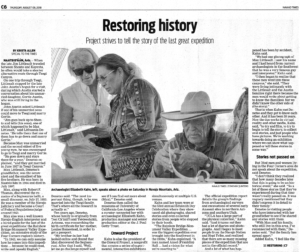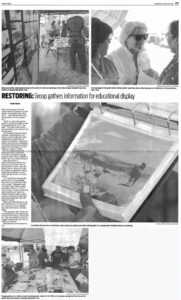

The ONWARD Project
Navajo Times Article “Restoring History; Project Strives to tell the story of the last great expedition”
By Krista Allen
Special to the Times
NAATSIS’AAN, Ariz — When the late Jim Littlesalt traveled between Shonto and Kayenta, he often would take a shorter alternative route through Tsegi Canyon. On one trip through Tsegi, Littlesalt stopped by the late John Austin’s hogan for a visit, during which Austin started a conversation about his unmarried daughter, Gertie Austin, who was still living in the hogan. John Austin asked Littlesalt if one of his unmarried sons could move to Tsegi and marry Gertie. “Jim goes back up to Shonto and tells (his sons), one of which happened to be Max Littlesalt,” said Lithuania Denetso. “He tells them that one of them has to go down and marry Gertie.” Because Max was unmarried and the second eldest of five young men, he was encouraged to go to Tsegi and marry Gertie. “He goes down and stays there for a year,” Denetso explained, “and they got married in June 1927 in Tsegi Canyon.” Max Littlesalt, Denetso’s grandfather, was the scrawniest and the smallest of his five brothers. He was born in Naatsis’aan in 1904 and died in July 1997. Max, along with Robert F. Thomas, discovered the remains of a Segisaurus halli, a small dinosaur, on July 27, 1933. He was a member of the Navajo judiciary and became a Court of Federal Regulations judge around 1953. Ma also was a well known Navajo-English interpreter and a hired guide for the last of the great expeditions: the Rainbow Bridge-Monument Valley Expedition, an extensive study of the Four Corners region’s history. “In 1943, we can only assume how he comes into this (expedition)… because he could read, write and (speak) English,” Denetso said. “The most important thing, though, is he was married into the Tsegi family. That’s where all the research is actually at.” Ten years ago, Denetso, whose family is originally from Teel Ch’inil?i and Tsedeeshchii, Arizona, was researching the birth certificate for her mother, Louise Homestead, in order to get a passport. “My brother-in-law had looked online and (found that Max discovered the Segisaurus). After that I said, ‘Well, let me go challenge myself and see if I can find out more about (Max),”’ Denetso said. Denetso then called the museums at University of California- Los Angeles where a curator connected her with archaeologist Elizabeth Kahn, production manager and senior production editor at the J. Paul Getty Trust.
Onward Project
Kahn is also the president of the Onward Project, a nonprofit that creates a series of experimental, interactive exhibitions simultaneously at multiple U.S. venues. Kahn and her team were at the 53rd annual Eehaniih Day Celebration where they showcased old photographs, shared stories and even collected stories from people who stopped by their booth. “The Rainbow Bridge-Monument Valley Expedition… was the biggest expedition ever brought into the Southwest in the 1930’s,” Kahn explained. “A man named Ansel (Franklin) Hall… had a vision for what we’re reacting to. The official expedition report details the group’s findings from archaeological surveys and excavations of several early Anasazi sites in northern Arizona and southern Utah. “UCLA has a large part of the physical collection,” Kahn said. “And it turns ou they had a lot of diaries and photographs. And I began to meet people from the Navajo Nation and Hopi Tribe, and realized that there are so many missing pieces of the expedition that are not in the official record.” And a lot of what has happened has been by accident, Kahn said. “We had one photograph of Max Littlesalt. I saw his name and I had heard from current archaeologists in the Southwest that he was a very famous guy and interpreter, “ Kahn said. “I then began to realize that these men went into these canyons,” she said. “They were living intimately with the Littlesalts and the Austin families right there because the men would write about getting to know the (families), but we didn’t know the other side of (the story).” That is when Kahn met Denetso and they got to know each other. And it has been 10 years. Now the duo works in virtual reality and other media, Kahn said, “to try and film, to try to begin to tell the story, to collect oral stories, and just people who have pictures. We’re working towards doing an exhibition where we can show what happened or tell these stories in some way.”
Stories not passed on
But Dine men and women living in the Four Corners area do not speak about the expedition, said Denetso. “I don’t think they realized that how many decades later that the is going to be an historical event,” she said. “So a lot of those stories that they’ve experienced during that time wasn’t really passed on. It was vaguely mentioned but they didn’t express it in detail to their family.” Denetso is visiting people who have interacted with her grandfather to see if he shared any stories with them. “With Max and his family, who still live in this area, I’ve reconnected with them,” Denetso said. “But the family has spread apart.” Added Kahn, “I feel like the diary entries that the men wrote about Lithuania’s grandfather, that makes him come alive… and putting that with his pictures, it’s very powerful.” “Early on, the men participated in a field day (which later became Eehaniih Day),” she said. “They did a tug of war— the expedition crew against the Navajo men.” The Onward Project recently received a $10,000 grant, two interns, and a workspace with equipment through Art Center in Pasadena, California. Kahn’s team is now developing a prototype of what the exhibition might look like when it is complete in a couple of weeks. But it has been nearly 90 years since the expedition. If another expedition should happen today, what would be a better way to go about doing it? Hans Baumann, a Swiss-American artist and a land art practitioner who is part of Kahn’s team, says the initial idea is, How can a tool be created to empower stories about the landscape specifically Navajo stories, in seven weeks? “If I could have one goal for this project, it’s that people don’t see it as something that we’ve made,” Baumann said. “It’s just kind of like a public good, like a library. The Onward Project has this extensive understanding of these historical archives and trying to create a technical framework that helps bring that into the modern world.” Kahn says this project is not just something to be exhibited in a museum in Los Angeles, but rather for Navajo communities. “For instance, the Navajo Nation Museum is very interested in what we’re doing,” Kahn added. “But I feel that it can be at a chapter house level too. This is what’s so critical.”
